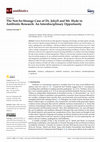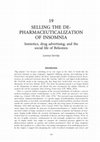Monographs by Lorenzo Servitje

Medicine is most often understood through the metaphor of war. We encounter phrases such as “the ... more Medicine is most often understood through the metaphor of war. We encounter phrases such as “the war against the coronavirus,” “the front lines of the Ebola crisis,” “a new weapon against antibiotic resistance,” or “the immune system fights cancer” without considering their assumptions, implications, and history. But there is nothing natural about this language. It does not have to be, nor has it always been, the way to understand the relationship between humans and disease.
Medicine Is War shows how this “martial metaphor” was popularized throughout the nineteenth century. Drawing on the works of Mary Shelley, Charles Kingsley, Bram Stoker, Arthur Conan Doyle, and Joseph Conrad, Lorenzo Servitje examines how literary form reflected, reinforced, and critiqued the convergence of militarism and medicine in Victorian culture. He considers how, in migrating from military medicine to the civilian sphere, this metaphor responded to the developments and dangers of modernity: urbanization, industrialization, government intervention, imperial contact, crime, changing gender relations, and the relationship between the one and the many. While cultural and literary scholars have attributed the metaphor to late nineteenth-century germ theory or immunology, this book offers a new, more expansive history stretching from the metaphor’s roots in early nineteenth-century militarism to its consolidation during the rise of early twentieth-century pharmacology. In so doing, Servitje establishes literature’s pivotal role in shaping what war has made thinkable and actionable under medicine’s increasing jurisdiction in our lives. Medicine Is War reveals how, in our own moment, the metaphor remains conducive to harming as much as healing, to control as much as empowerment
Articles by Lorenzo Servitje

Antibiotics, 2020
Literary-rhetorical devices like figurative language and analogy can help explain concepts that e... more Literary-rhetorical devices like figurative language and analogy can help explain concepts that exceed our capacity to grasp intuitively. It is not surprising these devices are used to discuss virulence, pathogenesis, and antibiotics. Allusions to Robert Louis Stevenson’s Strange Case of Dr. Jekyll and Mr. Hyde seem to be used with particular frequency in research pertaining to pathogens, especially in studies contemporary with our evolving understanding of antibiotic resistance. More recent references to the text have appeared in research parsing definitions of virulence and acknowledging the role of anti-virulence in future therapeutics. While it is obvious that scientists invoke Stevenson’s story for stylistic purposes, its use could go beyond the stylistic—and might even generate rhetorical and imaginative possibilities for framing research. This perspective discusses the first published allusion to Jekyll and Hyde in reference to virulence and pathogenesis; comments on a select number of specific instances of Jekyll and Hyde in contemporary scientific literature; briefly contextualizes the novel; and concludes with the implications of a more productive engagement with humanistic disciplines in the face of antibiotic resistance

Osiris, 2019
Since the turn of the twenty-first century, there has been an increasing number of articles in th... more Since the turn of the twenty-first century, there has been an increasing number of articles in the popular press on antibiotic resistance, a great many of which present the phenomenon in the science-fictional language of the "post-antibiotic apocalypse." In an effort to increase public awareness, the Longitude Prize, funded by the United King-dom's National Endowment for Science, Technology, and the Arts (NESTA), created the mobile video game Superbugs in 2016. This essay shows how the mobile gaming medium responds to and performs the science fictionality of the antibiotic apocalypse in a way that has consequences for the history of science. Superbugs mediates a shift in the conceptual metaphor of a war between humans and bacteria to an interrelational model of coexistence. By defamiliarizing both the history and current representations of antibiotic resistance, the game gives us a unique way to reflect on the conditions that fostered this survival facility in the bacteria genome.

Within its first week, Plague Inc. climbed to the top of Apple’s App Store, effectively ending th... more Within its first week, Plague Inc. climbed to the top of Apple’s App Store, effectively ending the ever-popular Angry Birds’ reign as the top-selling iPhone game. The game’s premise is simple: create a pathogen to kill every human on the planet. In this article, I examine the epidemiological images and structures in Plague Inc., suggesting that what Priscilla Wald has characterized as the “outbreak narrative” becomes reconfigured by the fictionalization of biosecurity in the biomedical imaginary according to the mobile game’s media specificity. This digital mutation of the outbreak narrative speaks to the implications of mobile technologies in the apperception and expansion of biosecurity and biopolitical regulation. Within this framework, I explore how Plague Inc.’s narrative content and interactive functions hover somewhere between science fiction and science fact. Ultimately, Plague Inc. participates in the reinscription of anxieties relating to a bio-apocalypse and of the desire for the biogovermental process to control it. I suggest that analyzing the game’s mechanics, narrative, and materiality, on the one hand, gives us a way to understand how the biopolitics of outbreak narratives work; on the other hand, we come to see the way the game also inculcates an acceptance of the biosecurity apparatus’ regulating biopolitics.

This article reveals how Edward Berdoe's St. Bernard's: The Romance of a Medical Student (1887) c... more This article reveals how Edward Berdoe's St. Bernard's: The Romance of a Medical Student (1887) critiques the evolution of medical science at the fin de siècle. Berdoe deploys the discourse of degeneracy to challenge the culture of medical education that produces monstrous medical students. St. Bernard's reflects not only the ambiguity towards scientific materialism and knowledge, which entails learning how to prolong life by encountering death, but also critiques the foundations of late Victorian medical education by articulating how the middle class was complicit in the horrors that the novel would expose, ultimately suggesting that middle-class health was built on the bodies of the poor. The text's ethical imperative to reform the medical establishment, however, derives its rhetorical power from provoking anxieties of corrupting middle-class health with working-class and pauper bodies. This reveals the novel's problematic use of degeneracy, as St. Bernard's reinscribes some of the very tenets about class that it aims to critique.

Games and Culture, Jul 22, 2014
Since its release, Visceral Games
Inferno has received much criticism in the popular press but ... more Since its release, Visceral Games
Inferno has received much criticism in the popular press but little critical attention from game studies. The game’s transformation of the medieval poet into a crusader not only raises concerns about the intersections between video games and war, as Patrick Crogan has observed using other examples,but also asks us to consider the implications of remediating a canonical textual form into an interactive one. I examine the specific textual uses of violence in the game to argue that the appropriation of Inferno presents the mortification of the cross on the hero’s flesh as an emblem for the narrative’s critique of the modern War on Terror as a crusade. Furthermore, I suggest that, simultaneously, the cross emblematizes the remediation of the 14th-century poem into the video game, accounting for a paratextual ‘‘war’’ between the original poem and the appropriated video game.

Journal of Medical Humanties
This paper argues that the graphic adaptation of Dennis Lehane’s Shutter Island utilizes the medi... more This paper argues that the graphic adaptation of Dennis Lehane’s Shutter Island utilizes the medium to evoke an affective participation and investment from the reader. It explores the ways the graphic novel overcomes problematic representations of mental illness in the popular film version. Drawing on graphic fiction theory, I contend that readers’ engagement in and construction of the story between panels, in the “gutters,” allows them to participate in the protagonist’s persecutory delusion. Additionally, I draw on Foucault’s conceptualizations of the medical gaze and historical figurations of madness connected to water in order to demonstrate the mechanism by which the reader is placed in a dual subject position, becoming both observer and observed. In this capacity, I suggest that graphic fiction provides a unique experience to engender empathy for psychiatric illness.
Edited Collections by Lorenzo Servitje
Syphilis and Subjectivity
Endemic: Essays in Contagion Theory, co-editor with Lorenzo Servitje. London: Palgrave Macmillan, 2016.

The Walking Med: Zombies and the Medical Image
The zombie craze has infected popular culture with the intensity of a viral outbreak, propagating... more The zombie craze has infected popular culture with the intensity of a viral outbreak, propagating itself through text, television, film, video games, and many other forms of media. As a metaphor, zombies may represent political notions, such as the return of the repressed violence of colonialism, or the embodiment of a culture obsessed with consumerism. Increasingly, they are understood and depicted as a medicalized phenomenon: creatures transformed by disease into a threatening vector of contagion.
The Walking Med brings together scholars from across the disciplines of cultural studies, medical education, medical anthropology, and art history to explore what new meanings the zombie might convey in this context. These scholars consider a range of forms—from comics disseminated by the Centers for Disease Control and Prevention to graphic novels and television shows such as The Walking Dead—to show how interrogations of the zombie metaphor can reveal new perspectives within the medical humanities.
An unprecedented forum for dialogue between cultural studies of zombies and graphic medicine, The Walking Med is an invaluable contribution to both areas of study, as well as a potent commentary on one of popular culture’s most invasive and haunting figures.
In addition to the editors, the contributors are Tully Barnet, Gerry Canavan, Daniel George, Michael Green, Ben Kooyman, Sarah Juliet Lauro, Juliet McMullin, Kari Nixon, Steve Schlozman, Dan Smith, and Darryl Wilkinson.
Book Chapters by Lorenzo Servitje

The Routledge Companion to the Health Humanities., 2020
This cultural study of a 2015 advertisement for Merk & Co’s sleeping medication Belsomra yields i... more This cultural study of a 2015 advertisement for Merk & Co’s sleeping medication Belsomra yields insight into the commodification of health and wellness, and the ideological underpinnings that shape how individuals in Western culture define themselves as productive, responsible, and healthy. It summarizes the broader contexts of direct-to-consumer drug advertising and the sociological scholarship on insomnia to frame a semiotic close reading of the 2015 Belsomra advertisement. To this effect, this chapter details the ad’s narrative and filmic strategies, as they navigate the tension between the pejorative connotations attached to “sleeping pills” and the medicalized imperative to live better though chemistry. This analysis demonstrates how interdisciplinary health humanistic work can provide nuanced understandings of the relationship between a drug’s biological, societal, and cultural effects. This reading not only contributes to the existing critiques of medicalization but also affords a unique opportunity to improve interactions between prescribers and patients by modeling a practice of collaborative interpretation.
“Introduction: The Making of a Modern Endemic.” Endemic: Essays in Contagion Theory. Co-written and edited with Lorenzo Servitje. London: Palgrave Macmillan, 2016.

"Contagion and Anarchy: Matthew Arnold and the Disease of Modern Life.” Lorenzo Servitje and Kari Nixon (eds). Endemic: Essays in Contagion Theory. Palgrave Macmillan, 2016
This chapter historicizes how Matthew Arnold’s mid-to-late writings on culture facilitated the en... more This chapter historicizes how Matthew Arnold’s mid-to-late writings on culture facilitated the endemicity of thinking of cultural contagion as a threat to social order in biological terms. It argues that Arnold saw cultural forms, like literature, as both a threat and antidote for the diseased state of Victorian England. Reading Arnold within the context of the period’s sociological theories of contagious crowd behaviors and the advent of germ theory reveal how culture became a way to understand and attempt to control the vivification and spread of potentially dangerous ideas and affects: from unrestrained liberty and revolution to infectious and pernicious literature. Ultimately, this understanding leads to a new way to think about the roots of cultural study and its links to biomedical history.
“Open up a Few Zombie Brains: A Critique of Neuroimaging in Steven Schlozman’s The Zombie Autopsies.” The Walking Med: Zombie Narratives and the Medical Image Lorenzo Servitje and Sherryl Vint (eds). Pennsylvania State University, 2016
"Graphic Medicine Contracts the Zombie Craze: An Introduction." The Walking Med: Zombie Narratives and the Medical Image. Lorenzo Servitje and Sherryl Vint (eds). Pennsylvania State University Press, 2016
Book Reviews by Lorenzo Servitje
They All Knew Jack. Review of They All Loved Jack: Busting the Ripper by Bruce Robinson. Los Angeles Review of Books











Uploads
Monographs by Lorenzo Servitje
Medicine Is War shows how this “martial metaphor” was popularized throughout the nineteenth century. Drawing on the works of Mary Shelley, Charles Kingsley, Bram Stoker, Arthur Conan Doyle, and Joseph Conrad, Lorenzo Servitje examines how literary form reflected, reinforced, and critiqued the convergence of militarism and medicine in Victorian culture. He considers how, in migrating from military medicine to the civilian sphere, this metaphor responded to the developments and dangers of modernity: urbanization, industrialization, government intervention, imperial contact, crime, changing gender relations, and the relationship between the one and the many. While cultural and literary scholars have attributed the metaphor to late nineteenth-century germ theory or immunology, this book offers a new, more expansive history stretching from the metaphor’s roots in early nineteenth-century militarism to its consolidation during the rise of early twentieth-century pharmacology. In so doing, Servitje establishes literature’s pivotal role in shaping what war has made thinkable and actionable under medicine’s increasing jurisdiction in our lives. Medicine Is War reveals how, in our own moment, the metaphor remains conducive to harming as much as healing, to control as much as empowerment
Articles by Lorenzo Servitje
Inferno has received much criticism in the popular press but little critical attention from game studies. The game’s transformation of the medieval poet into a crusader not only raises concerns about the intersections between video games and war, as Patrick Crogan has observed using other examples,but also asks us to consider the implications of remediating a canonical textual form into an interactive one. I examine the specific textual uses of violence in the game to argue that the appropriation of Inferno presents the mortification of the cross on the hero’s flesh as an emblem for the narrative’s critique of the modern War on Terror as a crusade. Furthermore, I suggest that, simultaneously, the cross emblematizes the remediation of the 14th-century poem into the video game, accounting for a paratextual ‘‘war’’ between the original poem and the appropriated video game.
Edited Collections by Lorenzo Servitje
The Walking Med brings together scholars from across the disciplines of cultural studies, medical education, medical anthropology, and art history to explore what new meanings the zombie might convey in this context. These scholars consider a range of forms—from comics disseminated by the Centers for Disease Control and Prevention to graphic novels and television shows such as The Walking Dead—to show how interrogations of the zombie metaphor can reveal new perspectives within the medical humanities.
An unprecedented forum for dialogue between cultural studies of zombies and graphic medicine, The Walking Med is an invaluable contribution to both areas of study, as well as a potent commentary on one of popular culture’s most invasive and haunting figures.
In addition to the editors, the contributors are Tully Barnet, Gerry Canavan, Daniel George, Michael Green, Ben Kooyman, Sarah Juliet Lauro, Juliet McMullin, Kari Nixon, Steve Schlozman, Dan Smith, and Darryl Wilkinson.
Book Chapters by Lorenzo Servitje
Book Reviews by Lorenzo Servitje
Medicine Is War shows how this “martial metaphor” was popularized throughout the nineteenth century. Drawing on the works of Mary Shelley, Charles Kingsley, Bram Stoker, Arthur Conan Doyle, and Joseph Conrad, Lorenzo Servitje examines how literary form reflected, reinforced, and critiqued the convergence of militarism and medicine in Victorian culture. He considers how, in migrating from military medicine to the civilian sphere, this metaphor responded to the developments and dangers of modernity: urbanization, industrialization, government intervention, imperial contact, crime, changing gender relations, and the relationship between the one and the many. While cultural and literary scholars have attributed the metaphor to late nineteenth-century germ theory or immunology, this book offers a new, more expansive history stretching from the metaphor’s roots in early nineteenth-century militarism to its consolidation during the rise of early twentieth-century pharmacology. In so doing, Servitje establishes literature’s pivotal role in shaping what war has made thinkable and actionable under medicine’s increasing jurisdiction in our lives. Medicine Is War reveals how, in our own moment, the metaphor remains conducive to harming as much as healing, to control as much as empowerment
Inferno has received much criticism in the popular press but little critical attention from game studies. The game’s transformation of the medieval poet into a crusader not only raises concerns about the intersections between video games and war, as Patrick Crogan has observed using other examples,but also asks us to consider the implications of remediating a canonical textual form into an interactive one. I examine the specific textual uses of violence in the game to argue that the appropriation of Inferno presents the mortification of the cross on the hero’s flesh as an emblem for the narrative’s critique of the modern War on Terror as a crusade. Furthermore, I suggest that, simultaneously, the cross emblematizes the remediation of the 14th-century poem into the video game, accounting for a paratextual ‘‘war’’ between the original poem and the appropriated video game.
The Walking Med brings together scholars from across the disciplines of cultural studies, medical education, medical anthropology, and art history to explore what new meanings the zombie might convey in this context. These scholars consider a range of forms—from comics disseminated by the Centers for Disease Control and Prevention to graphic novels and television shows such as The Walking Dead—to show how interrogations of the zombie metaphor can reveal new perspectives within the medical humanities.
An unprecedented forum for dialogue between cultural studies of zombies and graphic medicine, The Walking Med is an invaluable contribution to both areas of study, as well as a potent commentary on one of popular culture’s most invasive and haunting figures.
In addition to the editors, the contributors are Tully Barnet, Gerry Canavan, Daniel George, Michael Green, Ben Kooyman, Sarah Juliet Lauro, Juliet McMullin, Kari Nixon, Steve Schlozman, Dan Smith, and Darryl Wilkinson.